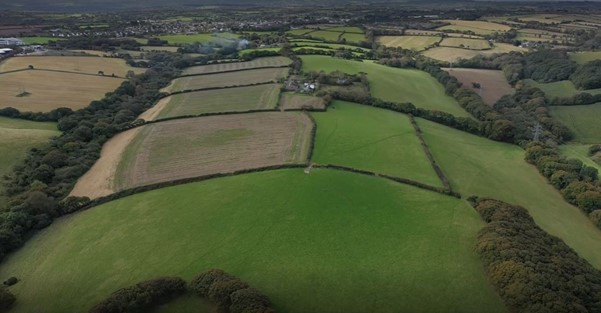By applying the BwN Standards to the design of Langarth Garden Village, the scheme is on track to deliver high-quality GI that supports delivery of its strategic objectives in relation to climate, water management, biodiversity and public health. In appraising the quality of the GI in the scheme, Building with Nature confirmed that proposals for the scheme deliver:
A strong vision for an interconnected GI network: Consideration has been given to delivering a wide range of benefits across the new settlement relating to: health and wellbeing, landscape character, protecting and enhancing heritage and local distinctiveness to create a sense of place, community cohesion, biodiversity protection and overall enhancement, sustainable surface water management and mitigation and adaptation to climate change. The master plan for the scheme has made a clear commitment to maintaining the majority of existing GI assets, (around 40 per cent of the development site is proposed as GI), as well as linking with GI assets off site, using a variety of appropriate new and enhanced habitats and landscaping features. The strong vision for the GI will deliver gains for wildlife, integrate SuDS into the landscape, offer local amenity and provide attractive green travel routes that connect across the site and into surrounding settlements.
Adaptive, local, nature-based solutions to address the climate emergency: Designs create climate change resilience through multiple measures including, reducing car reliance by encouraging active travel and landscape design that delivers shading, evaporative cooling, flood resilience, carbon storage and shelter from strong winds. Sustainable design principles are embedded in the proposals and will make a significant contribution towards Cornwall Council's action plan to tackle the climate emergency. The issue of sustainable soil management has also been considered, with the inclusion of a high-level soil strategy.
An exemplar scheme for biodiversity gains: The proposals for the development will be delivering around 20 per cent BNG, which exceeds the national mandatory requirement, and local plan policy targets. The scheme seeks to protect and enhance existing on-site biodiversity, avoid negative impacts and minimise the need for restoration and compensation measures.
Proposals include for significant Suitable Alternative Natural Greenspace (SANG) to offer recreational and biodiversity benefits to the new residents. The first phase of SANG (just under 30ha) will be delivered at the start of Phase 1 of the development.
Sustainable drainage systems (SuDS) will enhance biodiversity and the built environment will also support biodiversity, with integrated features such as bat, bird and bee bricks and green roofs on all new buildings and Hedgehog holes required in fencing.
Community health and wellbeing benefits: The 10 design principles for the scheme were developed in collaboration with a range of stakeholders, and in reference to a specific national guidance relating to Garden City Standards. The design principles promote healthy and active lifestyles and a strong sense of community wellbeing. Utilising these principles, the scheme will create a distinctive new place to live, work and play.
Designs have considered inclusivity, proposals include 35 per cent affordable housing (for local people), as well as homes for key workers such as nurses and teachers, and extra care housing for older people and people with disabilities. The Landscape Strategy sets out a range of types of GI features with the aim of providing accessible opportunities for all across the site.
A fully integrated SuDS strategy: Utilising SuDS to manage surface water and maximise benefits for people and wildlife. Throughout the site SuDS will be integral to the GI network incorporating an interconnected network of swales, infiltration basins, a wetland corridor and wet ponds to slow the flow of surface water run-off into the wider drainage system. The proposed scheme utilises existing (historic) field patterns, topography and water courses, to inform the design of the new SuDS strategy for the site.

